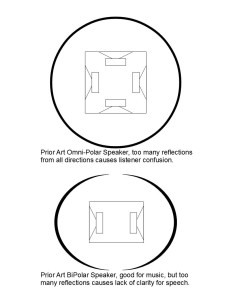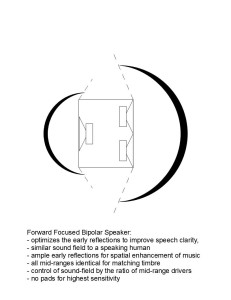The client had an established reputation for “Bipolar” speakers but wanted to improve the “imaging” without losing the bipolar’s enhanced sense of spaciousness. Through research and experimentation, we developed patent-pending IP for a new generation of bipolar speakers.
Bipolar speakers have two sets of transducers operating in-phase but in opposite

directions to enhance the spaciousness of the listening environment. In freestanding bipolar speakers, the transducer arrays are on 1) the forward face and 2) the rear face of the speaker. Conventional bipolar speakers have identical forward and rear transducer arrays.
One anecdote from the mono days of sound reproduction was that by turning the speakers around to face the wall, the sense of spaciousness would be improved. Famous experiments in the late 1980s confirmed that listeners preferred the sound of rearward facing speakers for music, but that they also preferred the sound of forward facing speakers for dialog. The same set of experiments found that the “sense of spaciousness” was as important as “flat on-axis frequency response” in determining listener preference for speakers.
We repeated the experiments but added an extra factor. Front and rear facing speakers were identical and played simultaneously. The loudness of the front and rear speakers were made independent and adjustable. The findings were that the enhanced sense of spaciousness was maintained even when the rear speakers were -10dB lower than the front speakers. A surprising finding was that speech clarity improved (over the direct sound only) when the rear speakers were -3 to -10 dB lower than the front speakers. Research indicated that there was a substantial body of evidence that adding early reflections to the acoustic signal would enhance clarity.
Implementation would be tricky. How should the reduction in rear SPL be obtained? If a

pad was used, the rear drivers would be underutilized and efficiency would be lost (efficiency = sales floor momentum). If smaller or less powerful drivers were used on the rear, then the rear sound would have a different timbre which would be audible. We developed a system of using integral ratios of drivers front to back; in the simplest case 2:1. To ensure the sound from the front and rear was identical 3 identical drivers were used in each array and they were wired in parallel. This required designing and engineering custom drivers to be placed 3 parallel.
Further experimentation determined that the front and back sound balance should be identical for greatest clarity and spaciousness, contrary to earlier work that equalized the rear soundfield to minimize measured front axis interference. The measured interference or “comb filtering” is a natural part of the enhancement of spaciousness. So, the front and rear were each voiced to be great standalone speakers in their own right, and the results combined. This is a case where the listening test prevailed over the measured SPL of the speaker.
This effort is further described in the pending patent application US20120014544-BP.
